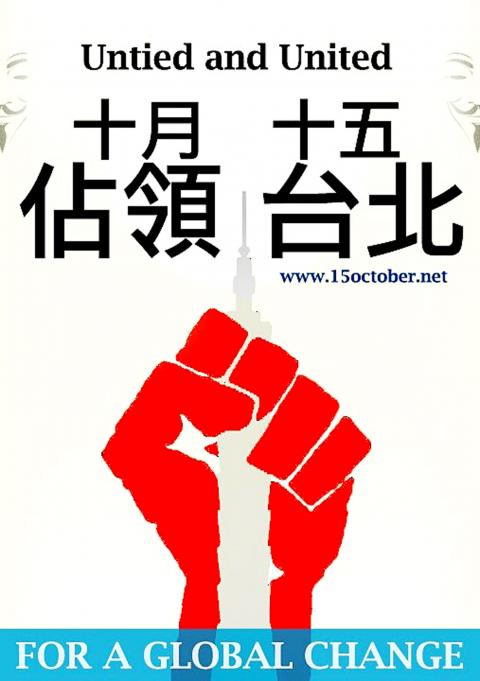The Occupy Wall Street protest that began on Sept. 17 in New York is spreading to Taiwan with Occupy Taipei (佔領台北), an event organized that takes place tomorrow outside Taipei 101, beginning at 1:01pm. As of yesterday, more than 1,400 people have said on the group’s Facebook page that they will join the event, which takes aim at social inequality and corporate greed. Although some foreign nationals have expressed concern that attending the protest may lead to arrest and possible deportation, the National Immigration Agency told the Taipei Times that foreign nationals who are legal residents of Taiwan could attend a protest if a permit has been applied for and granted six days before the protest date. As of Wednesday afternoon, the Xinyi Police Department had yet to receive an application from organizers. However, a message posted by co-organizer Kimba Vetten on the Occupy Taipei Facebook page said, “people who organize protests will be helping us and be informing people of their rights and what to say when police ask you questions. Taiwan hasn’t arrested protesters for a long time. Twenty years ago — yes, but not today. Anyway this is a peaceful gathering.”
■ Occupy Taipei (佔領台北), Taipei 101
■ Tomorrow beginning at 1:01pm

Photo courtesy of Occupy Taipei
■ On the Net: occupytaipei.tw

Most heroes are remembered for the battles they fought. Taiwan’s Black Bat Squadron is remembered for flying into Chinese airspace 838 times between 1953 and 1967, and for the 148 men whose sacrifice bought the intelligence that kept Taiwan secure. Two-thirds of the squadron died carrying out missions most people wouldn’t learn about for another 40 years. The squadron lost 15 aircraft and 148 crew members over those 14 years, making it the deadliest unit in Taiwan’s military history by casualty rate. They flew at night, often at low altitudes, straight into some of the most heavily defended airspace in Asia.

Many people in Taiwan first learned about universal basic income (UBI) — the idea that the government should provide regular, no-strings-attached payments to each citizen — in 2019. While seeking the Democratic nomination for the 2020 US presidential election, Andrew Yang, a politician of Taiwanese descent, said that, if elected, he’d institute a UBI of US$1,000 per month to “get the economic boot off of people’s throats, allowing them to lift their heads up, breathe, and get excited for the future.” His campaign petered out, but the concept of UBI hasn’t gone away. Throughout the industrialized world, there are fears that

Like much in the world today, theater has experienced major disruptions over the six years since COVID-19. The pandemic, the war in Ukraine and social media have created a new normal of geopolitical and information uncertainty, and the performing arts are not immune to these effects. “Ten years ago people wanted to come to the theater to engage with important issues, but now the Internet allows them to engage with those issues powerfully and immediately,” said Faith Tan, programming director of the Esplanade in Singapore, speaking last week in Japan. “One reaction to unpredictability has been a renewed emphasis on

Taiwan’s democracy is at risk. Be very alarmed. This is not a drill. The current constitutional crisis progressed slowly, then suddenly. Political tensions, partisan hostility and emotions are all running high right when cool heads and calm negotiation are most needed. Oxford defines brinkmanship as: “The art or practice of pursuing a dangerous policy to the limits of safety before stopping, especially in politics.” It says the term comes from a quote from a 1956 Cold War interview with then-American Secretary of State John Foster Dulles, when he said: ‘The ability to get to the verge without getting into the war is